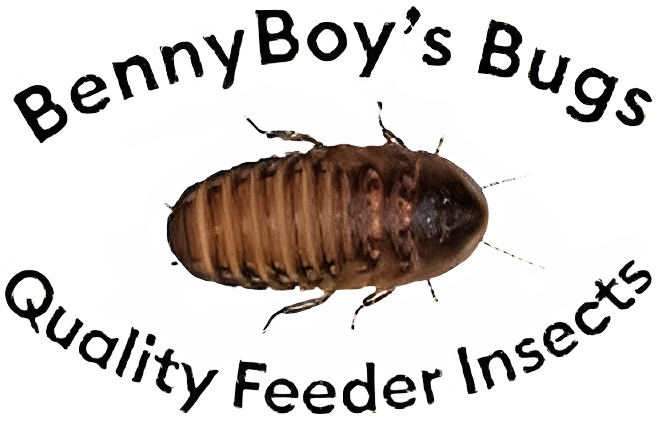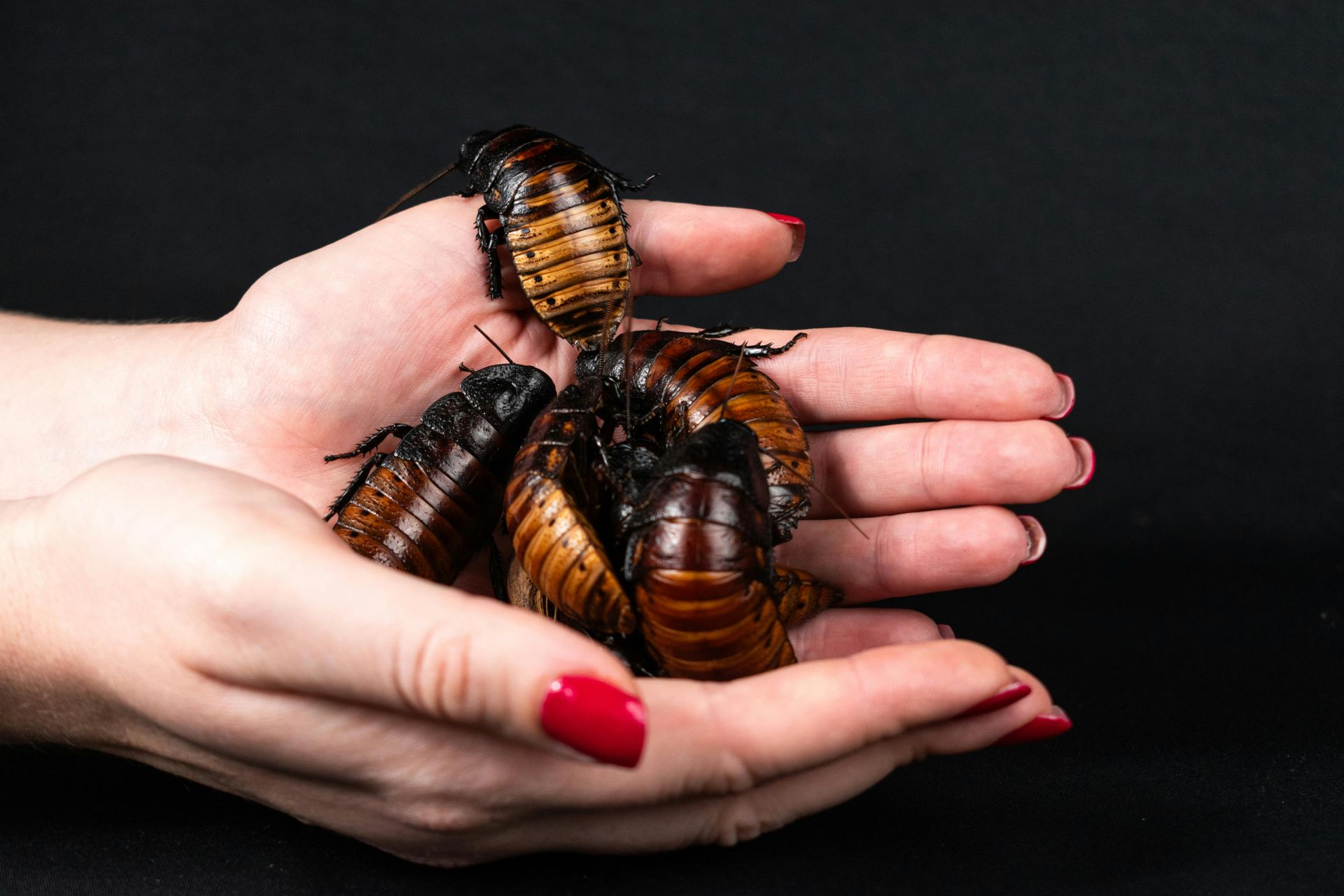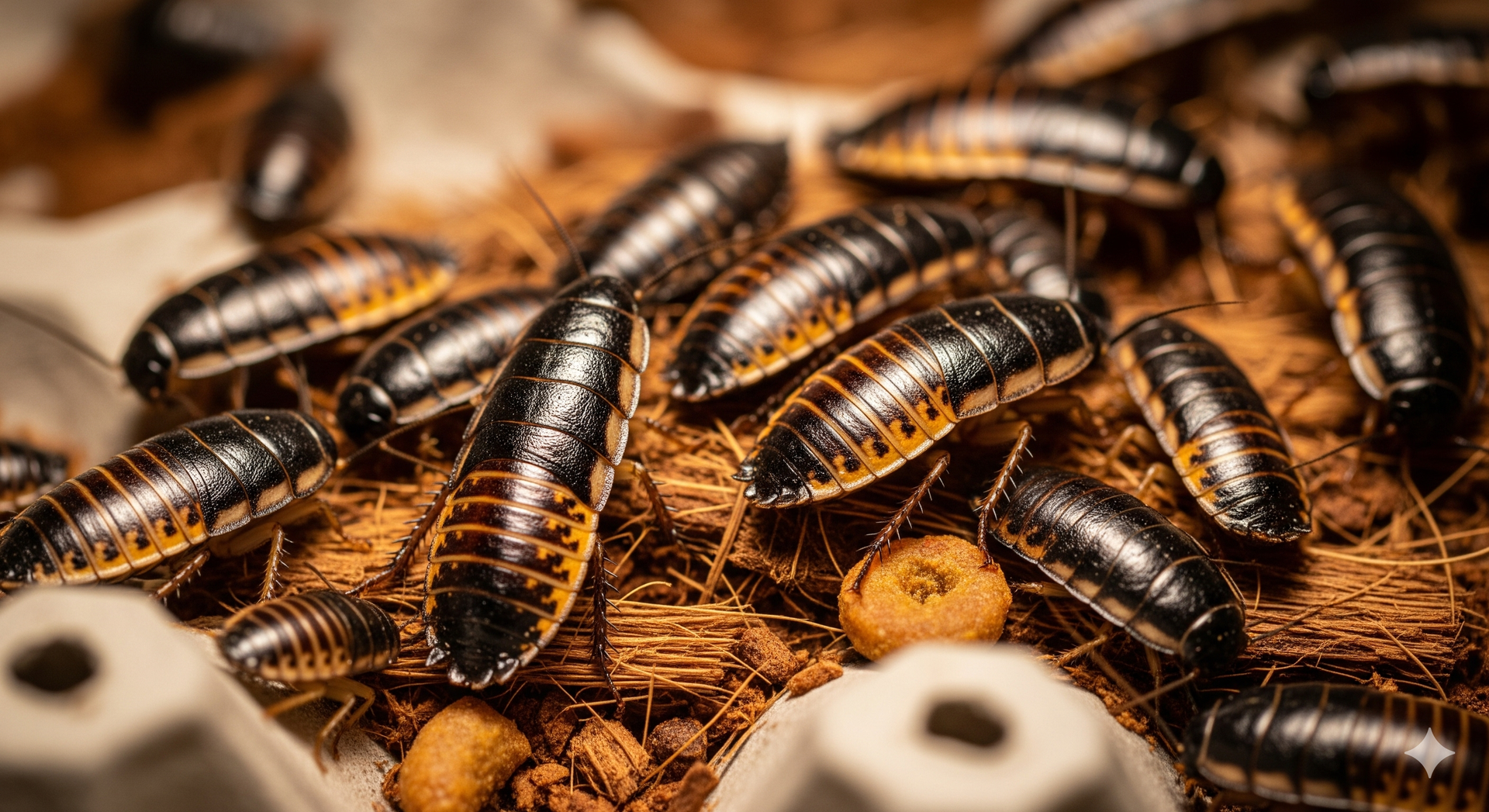Feeder Insects for Bearded Dragons: Why Dubia Roaches Are the Top Pick
When caring for bearded dragons, selecting the right feeder insects makes a significant difference in their health and development. Among the various options available, dubia roaches have emerged as the preferred choice for reptile enthusiasts and professionals alike.
Understanding "what are dubia roaches" and why they excel as feeder insects helps reptile owners make informed decisions about their pet's diet. Many bearded dragon owners struggle with inconsistent feeder insect quality, leading experienced keepers to recommend dubia roaches as the superior choice.
Key Takeaways
- Dubia roaches provide superior protein content and calcium-to-phosphorus ratios compared to crickets and mealworms
- These feeder insects are easier to digest and less likely to cause impaction in bearded dragons
- Dubia cockroaches offer longer shelf life and require minimal maintenance compared to other reptile feeder insects
- They produce less odor and noise, making them more suitable for home environments
- Proper dubia cockroach care ensures a consistent supply of nutritious food for your reptile
- Understanding dubia roach facts helps optimize feeding schedules and portion sizes for different life stages
Understanding What Are Dubia Roaches
What is a dubia roach exactly? The dubia cockroach (Blaptica dubia) is a species of cockroach native to Central and South America that has become the gold standard for reptile nutrition. Unlike common household cockroaches, dubia roaches cannot fly, climb smooth surfaces, or survive in typical home environments, making them safe and contained feeder insects.
These insects are significantly different from their pest cousins. Dubia cockroaches are larger, meatier, and contain higher levels of protein and essential nutrients. Adult females can reach up to 2 inches in length, while males are slightly smaller and feature wings that they cannot use for flight. This size variety makes them suitable for feeding bearded dragons of all ages.
The appearance of dubia roaches varies by gender and age. Females are broader and darker with a distinctive banded pattern, while males are narrower with more pronounced wing buds. Juveniles, often called nymphs, are smaller and lighter in color. This natural size gradation provides reptile owners with appropriate feeding options as their bearded dragons grow.
One of the most important dubia roach facts is their inability to establish colonies in typical household conditions. They require specific temperature and humidity ranges to reproduce, meaning escaped insects will simply die rather than infest your home. This safety feature sets them apart from other feeder insects and provides peace of mind for pet owners.
Nutritional Comparison of Feeder Insects for Bearded Dragons
| Feeder Insect | Protein % | Fat % | Ca:P Ratio |
|---|---|---|---|
| Dubia Roaches | 23-25 | 7-9 | 1:3 |
| Crickets | 18-20 | 6-8 | 1:9 |
| Mealworms | 16-18 | 12-15 | 1:16 |
This comparison clearly demonstrates why dubia roaches excel as reptile feeder insects. Their superior protein content and more balanced calcium-to-phosphorus ratio make them nutritionally superior to common alternatives like crickets and mealworms.
Why Dubia Roaches Excel as Feeder Insects
Dubia roaches for bearded dragons offer several practical advantages that make daily reptile care easier and more convenient:
- Softer exoskeleton breaks down easily in digestive tract, reducing impaction risks
- Size variety allows proper prey selection for dragons of all ages
- Virtually odorless when maintained properly, unlike smelly cricket colonies
- Quiet insects eliminate constant chirping noise in living spaces
Storage and longevity benefits make dubia roaches exceptionally convenient for busy reptile owners:
- Live several months with minimal care versus crickets' 1-2 week lifespan
- Move slowly and cannot climb smooth surfaces, making escapes manageable
- Easy to locate and recapture if they escape their enclosure
From an economic perspective, dubia roaches provide better value over time. Their longer lifespan means less frequent replacement, and their hardiness reduces losses due to die-offs that commonly affect cricket colonies. Additionally, their high nutritional density means fewer insects are needed per feeding, stretching your investment further.
Environmental considerations also favor dubias. They produce less waste, require less frequent cleaning, and consume feed more efficiently than other feeder insects. Their stable populations mean less environmental impact from frequent shipping and transportation compared to constantly replacing short-lived alternatives.
Health Benefits and Veterinary Perspectives
Veterinary professionals recommend dubia roaches for multiple health advantages. Digestive benefits include:
- Soft chitin provides beneficial fiber without causing digestive blockages
- Complete amino acid profile supports muscle development and immune function
- Higher protein content improves body condition scores compared to cricket diets
Additional health advantages for bearded dragon wellness include:
- Low pathogen load reduces bacterial and parasitic infection risks
- Consistent moisture content supports proper hydration and kidney function
- Better mineral absorption contributes to stronger bone development
Breeding and Colony Management for Advanced Keepers
For dedicated reptile enthusiasts managing multiple bearded dragons, establishing a breeding colony provides long-term cost savings and consistent availability. Basic breeding requirements include:
- Optimal male-to-female ratios of 3:1 to 7:1 females to males for reproduction
- Temperature consistency between 80-95°F for successful breeding cycles
- Gestation period of approximately 28-30 days with live birth
- Each female produces 15-40 nymphs per reproductive cycle
Colony harvesting strategies ensure sustainable production without depleting breeding stock:
- Remove only males and older females while preserving reproductive females
- Maintain breeding population stability for continuous production
- Monitor colony health and replace aging breeding stock as needed
Dubia Cockroach Care and Maintenance
Proper dubia cockroach care ensures productive and cost-effective feeder insect management. Basic housing requirements include:
- Plastic storage container with adequate ventilation holes covered by fine mesh
- Smooth-sided container to prevent climbing and egg carton hiding places
- Temperature between 80-90°F for optimal activity, 70-80°F to slow growth
Feeding and water management require attention to quality and cleanliness:
- High-protein base diet of dry dog food, fish flakes, or specialized roach chow
- Occasional fresh vegetables and fruits without compromising food majority
- Water crystals or sponge-filled dishes to prevent drowning and bacterial growth
Troubleshooting Common Dubia Roach Issues
Successful dubia roach management requires addressing potential challenges promptly. Common colony problems and solutions include:
- Odor issues: Increase ventilation, remove uneaten food promptly, reduce moisture
- Slow growth: Check temperature consistency, improve protein content in diet
- High mortality: Evaluate overcrowding, water quality, and food freshness
- Mites or pests: Quarantine affected colonies, clean containers thoroughly
Feeding challenges with picky bearded dragons require strategic approaches:
- Gradual transition from crickets by mixing both insects initially
- Hand-feeding or tong-feeding to encourage hunting behaviors
- Offering different sizes to match dragon preferences and comfort levels
Feeding Guidelines for Bearded Dragons
Age-specific feeding schedules ensure proper nutrition throughout your bearded dragon's development:
- Baby dragons under 4 months: Small nymphs 2-3 times daily, no larger than eye spacing
- Juvenile dragons: Once daily feeding with appropriately sized insects
- Adult dragons: Every other day, insects comprise 20% of the total diet
Nutritional enhancement techniques maximize feeding value:
- Gut-loading 24-48 hours before feeding transfers beneficial nutrients
- Calcium powder dusting for most feedings, vitamin D3 supplements 2-3 times weekly
- Seasonal adjustments during brumation periods with reduced feeding frequencies
Cost Analysis and Long-Term Economic Benefits
While initial costs may seem higher, dubia roaches provide superior long-term value compared to traditional feeder insects. Monthly cost comparisons reveal:
- Dubia roaches: Higher upfront cost but 1.5-2 year lifespan reduces replacement needs
- Crickets: Lower initial price but weekly replacement creates ongoing expenses
- Mealworms: Moderate pricing but high fat content requires dietary supplements
Additional economic advantages accumulate over time:
- Extended lifespan reduces replacement frequency and shipping costs
- Higher nutritional density requires fewer insects per feeding session
- Lower mortality rates minimize losses from die-offs during storage
- Reduced veterinary costs due to improved dragon health and nutrition
Environmental sustainability factors contribute to responsible reptile keeping:
- Efficient protein conversion from plant-based foods to high-quality nutrition
- Minimal water requirements and negligible greenhouse gas production
- Reduced transportation impact due to longer storage capabilities
Safety and Legal Considerations
Before establishing dubia roach colonies, understanding legal restrictions and safety protocols ensures responsible pet ownership. Legal considerations vary by location:
- Check local and state regulations regarding cockroach species ownership
- Some regions prohibit dubia roach importation or breeding activities
- Verify housing regulations if maintaining large breeding colonies
Safety protocols protect both reptiles and handlers during feeding routines:
- Hand washing before and after handling prevents cross-contamination
- Feeding tongs reduce direct contact and prevent accidental bites
- Proper ventilation in roach storage areas prevents respiratory irritation
Storage and Transportation Best Practices
Proper storage techniques maximize dubia roach lifespan and maintain nutritional quality. Short-term storage considerations include:
- Temperature range of 70-90°F maintains health and extends lifespan during storage
- Ventilated containers prevent moisture buildup and maintain air circulation
- Minimal feeding during storage prevents waste accumulation and odor development
Transportation guidelines ensure insects arrive healthy and ready for feeding:
- Secure packaging prevents escapes during shipping or transport
- Temperature-controlled shipping maintains insect viability during transit
- Quick processing upon arrival minimizes stress and mortality rates
Advanced Nutrition Optimization Techniques
Maximizing nutritional benefits requires strategic feeding approaches that enhance dubia roach quality. Gut-loading strategies include:
- High-calcium vegetables like collard greens and squash 24-48 hours before feeding
- Commercial gut-loading diets designed specifically for feeder insects
- Avoid high-phosphorus foods that negatively impact calcium absorption
Supplementation timing and techniques optimize nutrient delivery:
- Light dusting prevents supplement buildup while ensuring adequate coverage
- Rotate calcium and vitamin supplements to prevent over-supplementation
- Monitor dragon response to adjust supplementation frequency as needed
Feeding schedule optimization supports natural behaviors and digestion:
- Morning feeding aligns with bearded dragons' natural activity patterns
- Allow adequate basking time after feeding for proper digestion
- Observe individual dragon preferences for feeding frequency adjustments
Frequently Asked Questions
Are dubia roaches safe for all ages of bearded dragons?
Yes, dubia roaches are safe for bearded dragons of all ages when appropriately sized. Young dragons should receive small nymphs, while adults can handle full-grown roaches without difficulty.
How long can dubia roaches survive without food?
Dubia roaches can survive 2-4 weeks without food under proper temperature conditions. However, regular feeding ensures they maintain optimal nutritional content for your bearded dragon.
Can dubia roaches infest my home if they escape?
No, dubia roaches cannot establish infestations in typical home environments. They require specific temperature and humidity conditions that are not found in most households.
How many dubia roaches should I feed my adult bearded dragon?
Adult bearded dragons typically need 5-7 appropriately sized dubia roaches 2-3 times per week. Adjust quantities based on your dragon's size, activity level, and overall body condition.
Do dubia roaches need special lighting or heating?
Dubia roaches prefer warm temperatures between 80-95°F but do not require special lighting. A simple heat mat or ceramic heater provides adequate warmth for maintaining healthy colonies.
Final Thoughts
Dubia roaches represent the pinnacle of reptile feeder insects, offering unmatched nutritional benefits, practical advantages, and safety features that make them the clear choice for bearded dragon owners. Their superior protein content, balanced mineral ratios, and excellent digestibility support optimal health throughout your reptile's life stages.
Dubia roaches represent the best choice for bearded dragon nutrition and care convenience. Their superior protein content and digestibility support optimal health throughout your reptile's life. When you understand what dubia roaches are, you can ensure reliable, high-quality nutrition for your bearded dragon.
Give your bearded dragon the nutrition they deserve - order premium dubia roaches today!
Reference:
https://dubiaroachdepot.com/guidance/dubia-roach-care-sheet


